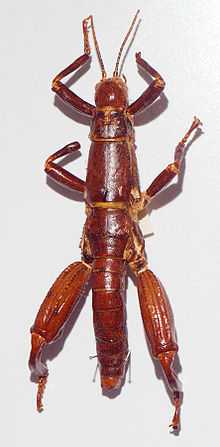Dryococelus australis
| Dryococelus australis | |
|---|---|
 | |
| Conservation status | |
| Scientific classification | |
| Kingdom: | Animalia |
| Phylum: | Arthropoda |
| Class: | Insecta |
| Order: | Phasmatodea |
| Family: | Phasmatidae |
| Genus: | Dryococelus |
| Species: | D. australis |
| Binomial name | |
| Dryococelus australis (Montrouzier, 1885) | |
Dryococelus australis, commonly known as the Lord Howe Island stick insect or tree lobster,[2] is a species of stick insect which lives on the Lord Howe Island Group. It was thought to be extinct by 1920, only to be rediscovered in 2001 (this phenomenon is known as the Lazarus effect). It is extinct in its largest habitat, Lord Howe Island, and has been called "the rarest insect in the world", as the rediscovered population consisted of 24 individuals living on the small islet of Ball's Pyramid.
Anatomy and behaviour
Adult Lord Howe Island stick insects can measure up to 15 centimetres (5.9 in) in length and weigh 25 grams (0.88 oz), with females 25% smaller than males. They are oblong in shape and have sturdy legs. Males have thicker thighs than females. Unlike most phasmids, the insects have no wings, but are able to run quickly.
The behaviour of this stick insect is highly unusual for an insect species. The males and females form a bond; the males follow the females and their activities depend on what the female is doing.
The females lay eggs while hanging from branches. Hatching can happen up to nine months later. The nymphs are first bright green and active during the day, but as they mature, they turn black and become nocturnal.
Reproduction can happen without the presence of males (parthenogenesis) and this facility has allowed the species to survive when they are low in numbers.[3]
History and conservation
The stick insects were once very common on Lord Howe Island, where they were used as bait in fishing. They became extinct there soon after black rats were introduced to the island in 1918 when the supply ship S.S. Makambo ran aground. The last one was seen on the island in 1920, and after that the species was thought to be extinct.[4] In 1964, a team of climbers visiting Ball's Pyramid, a rocky sea stack 23 kilometres (14 mi) south-east of Lord Howe Island, discovered a dead Lord Howe Island stick insect. During subsequent years, a few more dead insects were discovered, but expeditions to find live specimens were unsuccessful.
In 2001, two Australian scientists, David Priddel and Nicholas Carlile hypothesized that there was sufficient vegetation on the islet to support a population of the insects, and with two assistants travelled to the island to investigate further. They scaled 500 feet of rock, but only found crickets. On their descent, the team discovered large insect droppings under a single Melaleuca shrub growing in a crevice approximately 100 m (330 ft) above the shoreline. They deduced that they would need to return after dark, when the insects are active, to have the best chance of finding living specimens. Carlile returned with local ranger Dean Hiscox and, with a camera and flashlights, scaled the heights again. They discovered a small population of 24 insects living amongst a substantial buildup of plant debris beneath the Melaleuca shrub.[4]
In 2003, a research team from New South Wales National Parks and Wildlife Service returned to Ball's Pyramid and collected two breeding pairs, one destined for a private breeder in Sydney and the other sent to the Melbourne Zoo. After initial difficulties, the insects were successfully bred in captivity in Melbourne.[4] The ultimate goal was to produce a large population for reintroduction to Lord Howe Island, providing that a project to eradicate the invasive rats was successful. In 2006, the captive population of insects was about 50 individuals, with thousands of eggs waiting to hatch. In 2008, when Jane Goodall visited the zoo, the population had grown to 11,376 eggs and 700 individuals,[4] 20 of which were soon after returned to a special habitat on Lord Howe Island.[5] As of April 2012, the Melbourne Zoo has reportedly bred over 9,000 of the insects.[6]
See also
References
- ↑ ANZECC Endangered Fauna Network (2002). "Dryococelus australis". IUCN Red List of Threatened Species. Version 2009.2. International Union for Conservation of Nature. Retrieved 3 April 2010.
- ↑ Stohr, Stephanie (February 9, 2009). "Tree lobster came from ancient sunken island". Cosmos Magazine. Retrieved 25 July 2011.
- ↑ Mantle, Beth (24 January 2013). "Australian endangered species: Lord Howe Island stick insect". The Conversation. CSIRO. Retrieved 30 March 2013.
- ↑ 4.0 4.1 4.2 4.3 Krulwich, Robert (24 February 2012). "Six-Legged Giant Finds Secret Hideaway, Hides For 80 Years". NPR. Retrieved 29 February 2012.
- ↑ Lewis, Martin W. (3 August 2010). "Lord Howe Island: Return of the Tree Lobster". Geocurrents.info. Retrieved 29 February 2012.
- ↑ "Act Wild for Lord Howe Island Stick Insects". Zoos Victoria. Retrieved 5 November 2012.
External links
| Wikispecies has information related to: Dryococelus australis |
| Wikimedia Commons has media related to Dryococelus australis. |
- Sticky, a short film on the rediscovery of the Lord Howe Island Stick Insect
- Video of Stick insect hatching
- The Lord Howe Island Phasmid: an extinct species reborn by David Priddel, at the Foundation for National Parks & Wildlife
- Sticks and stones article, Sydney Morning Herald, 18 October 2003 (with picture)
- Giant stick insect rediscovered, science news 14 February 2001 at the Australian Broadcasting Corporation
- ABC news report, with video
- Phylogenetic study on Dryococelus australis
- “Six-Legged Giant Finds Secret Hideaway, Hides For 80 Years”
